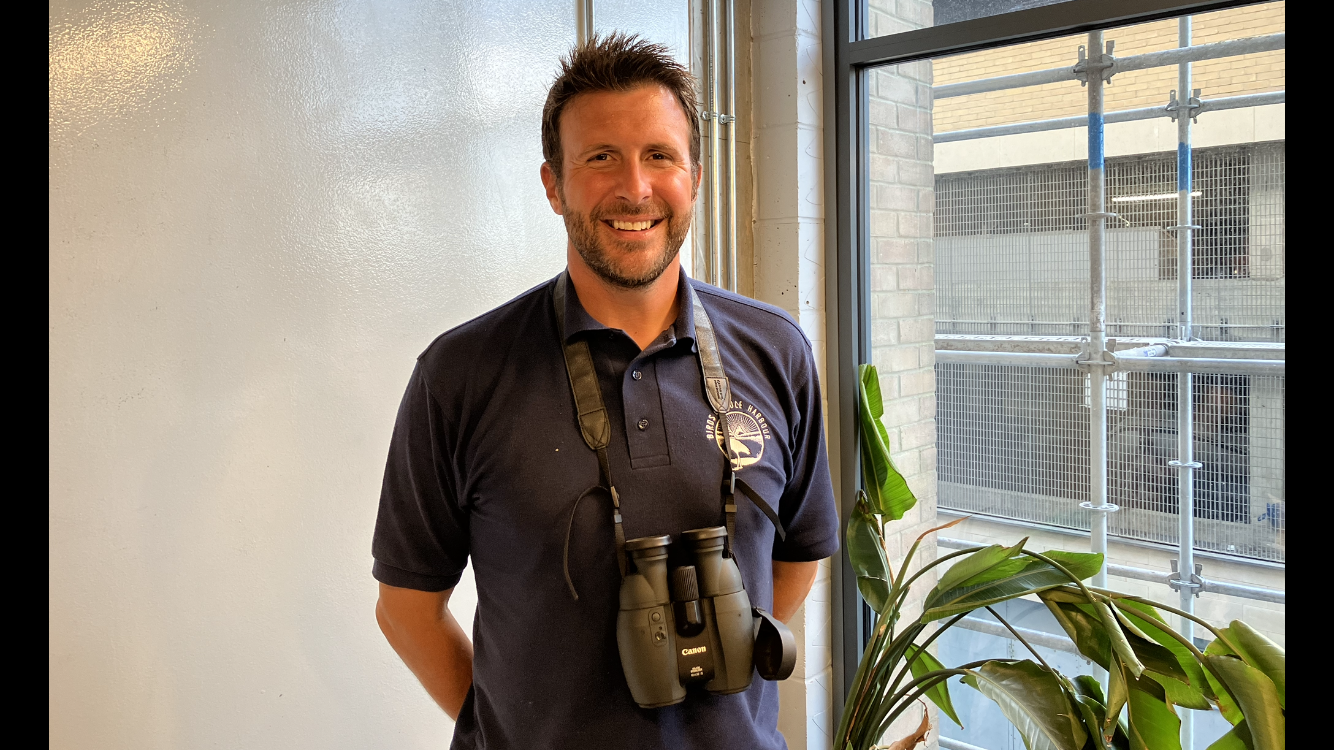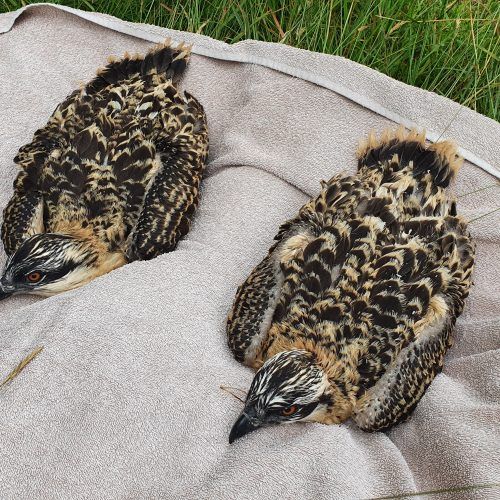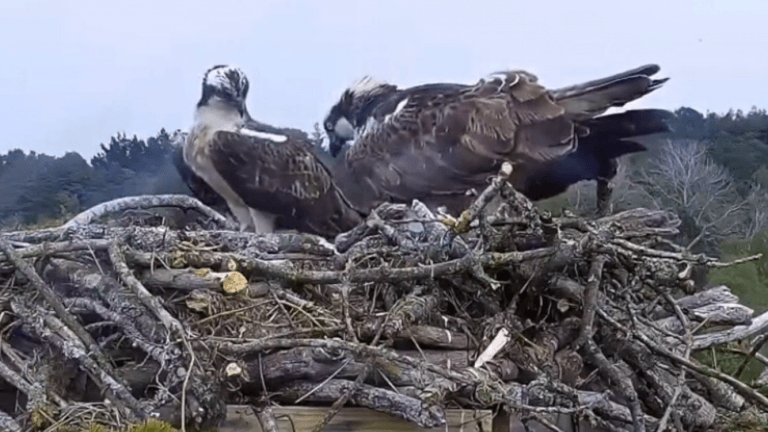Q&A with Paul Morton | Birds of Poole Harbour
On August 9th the Flight of the Osprey expedition team visited Poole Harbour where they got the chance to view the Ospreys and learn more about the project. Here we speak with Paul Morton, founder of the charity Birds of Poole Harbour. We cover topics such as why he loves Ospreys, and the highs and lows of life on the nest.

You’ve had a great year – can you explain why?
In 2017, we started our Osprey reintroduction with the aim of re-establishing a South Coast breeding population. This summer saw the first successful breeding attempt as a result of the reintroduction. The new pair male (022) and female (CJ7) raised two healthy female chicks, which were ringed in early July with the ring numbers 5H1 and 5H2. These were the first Osprey chicks to have hatched in southern Britain for nearly 200 years.

Can you describe a moment with the Osprey that demonstrates why they inspire awe and fascination in so many people?
Osprey have had a troubled and challenging history. When they began to recover as a species in the 1950’s, the public were invited to come and share in the joy of their return with the setting up of the Loch Garten visitor centre. As a result, the public have had a historic wide ranging, genuine interest in the Osprey’s life story and recovery.
Poole Harbour has attracted migrating Osprey for decades as they move north and south each year, but because of their historical persecution, none ever saw the harbour area as ‘home’. We knew the habitat and food source were in place, but just needed a few Osprey to recognise the harbour as home. So, it was concluded that a translocation should take place to try and imprint several birds to the area, as well as attract new Ospreys in.
What has been your highlight of the project so far?
There have been many ups and downs, but the definite highlight was the reaction on 022’s and CJ7’s faces when CJ7 laid her first egg on April 23rd. It was a very special moment when they both realised life was going to be very different from then on! Also, we now have young female Ospreys that we’ve released as part of the project that are now breeding at sites in Wales, meaning we’ve been able to connect known existing Osprey populations.

What has been the lowlight?
The low point was actually in the last 24 hours when one of our chicks died from an injury it sustained during a Goshawk predation attempt.
As background on August 7th, Osprey chick 5H2, was unfortunately at the receiving end of a predation attempt by a Goshawk and did not survive its injuries.
A statement on their website: “We hold no animosity towards this young Goshawk, and just see the incident as unfortunate. Goshawk have been heavily persecuted over many years and are trying to make their own recovery which seems to now be coinciding with the return of the Osprey. And while we can’t rule out any future predation attempts again, the fact that Osprey, Goshawk, White-tailed Eagles, Peregrine, Marsh Harrier and Red Kite are now all visible again over Poole Harbour skies, shows that times are changing and attitudes towards all raptors are improving”.
Before this reintroduction, when had Ospreys last been known to breed in the South of England?
The last known breeding attempt in the south was on the Somerset Levels in 1847
Why do you keep the location of nests quiet?
Ospreys are easily disturbed and can be flushed away from their nests due to human activity. Because this is the first year they’ve nested, the birds welfare has to be priority and we don’t currently have the measures in place to be able to deal with visiting public. We’ve learnt a lot this summer and hope that with the right management in place, we’ll eventually be able to invite the public to see the birds in a controlled and safe environment, both for the ospreys and the public.
What impact/benefit can bringing the Osprey back, have on people?
Osprey webcams provide incredible entertainment for people at home. We’ve had so many emails and messages stating that our Osprey webcam has helped them through some really challenging times.
In 2020, before our Ospreys bred, CJ7 was on a different webcam and provided a real tearjerker of a story for everyone whilst in lockdown. She was expecting her boyfriend LS7 (one of our 2017 translocated males) to come back, and he never arrived, so she was left all alone that year. This really caught the publics hearts, and many people became hooked on CJ7’s story. To date we’ve had no negative reactions to the project!

Have any birds from here been lost on migration?
Many of the birds we’ve released as part of the reintroduction have not retuned. This is typical for migrant Osprey heading south down to West Africa. They face many challenges, including hunting, adverse weather conditions, an ever-expanding Sahara Desert and of course natural predation.
Is the success of this reintroduction just about the osprey? Or is it more than that?
Our Osprey reintroduction is part of a much bigger and exciting story that’s unfolding. Here in Poole, we’re releasing Ospreys, on the Isle of Wight the Roy Dennis Wildlife Foundation are reintroducing White-tailed Eagles, locally the National Trust are looking to carry out a Beaver reintroduction, we’re now looking at the feasibility of doing a Chough reintroduction along the Purbeck Coast, large rewilding projects are now taking off all over the place.
Landowners, governmental organisations and politicians are now understanding that people want to see nature recover and are providing the stepping-stones to allow this to happen. There’s still a long way to go, but there’s definitely a shift and, for once, it’s in a positive direction.
Birds of Poole Harbour are partnered with the Roy Dennis Wildlife Foundation to deliver the Poole Harbour Osprey Translocation Project, aiming to restore a breeding population of these charismatic birds of prey to the South Coast. The project, which started in 2017, involves the translocation of 60 juvenile Ospreys from Scottish nests into the Poole Harbour area. This process aims to create a bond between the young Ospreys and their new local area, before they leave on their first treacherous migration, usually to West Africa. This bond draws the Ospreys back to Poole Harbour on their return to the UK, after at least 2 years maturing in their wintering grounds, when they will identifying suitable nesting sites. The translocation therefore lays the foundations for their return as a breeding bird to the South Coast, 180 years on from their local extinction.
For more information visit: www.birdsofpooleharbour.co.uk

